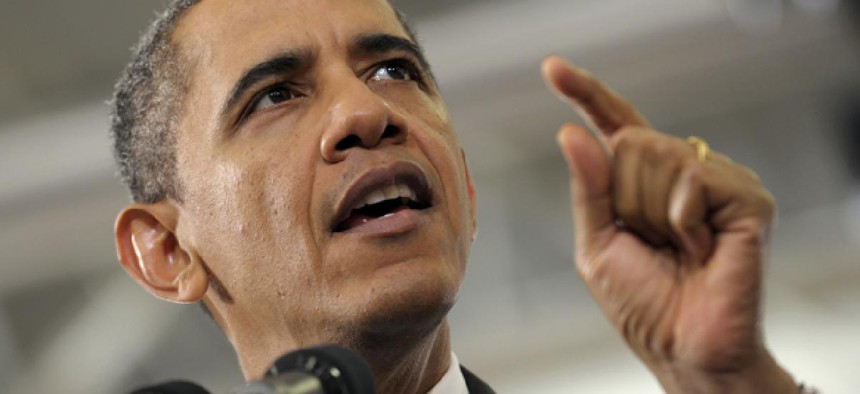
Susan Walsh/AP
Obama budget seeks savings via management reforms
Investments in research and green technology are coupled with consolidation and data-based evaluations.
President Obama’s fiscal 2013 budget released Monday is being billed as a blueprint that invests in short- and long-term needs through a balanced approach of increased revenues and spending cuts. It also offers “scores of cuts and consolidations,” including more than $7.5 billion in administrative savings.
Appearing at Northern Virginia Community College in Annandale, Va., Obama highlighted the document’s proposed investments in higher education and job training, while acknowledging “some difficult cuts that ordinarily we wouldn’t make unless absolutely necessary.”
The $3.8 trillion proposed budget lays out $4 trillion in cuts over 10 years, along with $1.5 trillion in tax increases on the wealthy. Obama administration officials presented the tax hikes on households earning more than $250,000 a year under the rubric of “shared sacrifice,” and said every dollar in the budget’s proposed new revenues is balanced against $2.50 in spending cuts.
The budget document projects a deficit of $1.33 trillion, or 8.5 percent of gross domestic product, for the year that ends Sept. 30. In 2013 the deficit would drop to $901 billion, or 5 percent of gross domestic product, though that could change depending on the coming political battle in Congress over the expiring 2001 and 2003 tax cuts and the fate of the threatened across-the board sequestration cuts in 2013 under the 2011 Budget Control Act.
Due for increased funding under Obama’s investment strategy are such programs as teacher hiring, school building modernization, rail and road construction, electric cars, and overall research and development. One of the major spending hikes would be $140.8 billion in research and development governmentwide, a 5 percent increase over the 2012 level. This would include doubling the research budgets of National Science Foundation, the Energy Department’s Office of Science, and the National Institute of Standards and Technology’s laboratories, OMB said. The budget also would make permanent the research and development tax credit.
Agriculture subsidies and defense overseas contingency operations are among the programs that would see decreases. Certain Medicare and Medicaid premiums would be raised.
The budget’s estimated $7.5 billion in savings in administrative costs would come from a range of efficiency efforts, many of which have been in place for much of Obama’s tenure. They include reducing printing and travel costs, decreasing energy costs in federal buildings, curbing improper payments, and continuing to sell off unneeded federal buildings. The administration’s budget reiterated its earlier proposal for a civilian board of experts to speed the process of shedding excess facilities.
Plans for efficiencies include, for example, changes at the National Institutes of Health, which would see its biomedical research funding level off but would implement new management policies to increase the number of research grants by 7 percent.
At the Transportation Department, a “fix-it first” policy would consolidate 55 duplicative highway programs and use a grant competition similar to the Education Department’s Race to the Top initiative to bring reform.
The efforts to trim administrative expenses are among 210 cuts, consolidations and savings measures in the budget that would collectively save more than $24 billion in 2013 and $520 billion through 2022, the administration said. The recommendations come after Obama in each of his first two budgets, put forward more than 120 program terminations, reductions and savings totaling about $20 billion annually. In 2012, the budget proposed more than 200 terminations, reductions and savings totaling some $30 billion in savings. The document did not say how many of those requests were enacted.
Savings of some $102 billion over 10 years are to be found in improvements in oversight governmentwide, the administration said. For example, the proposal suggests removing duplicative reports prepared for Congress.
The budget anticipates reductions in overhead, employee information technology devices, promotional material, and executive transport, which combined would save $8 billion in 2013.
Use of contractors for management support services would be cut by 15 percent, the budget said, and agencies should strengthen their suspension and debarment programs to reduce waste and fraud.
Agencies should use goals and frequent data-driven reviews to get more results for the taxpayer dollar, the budget said, noting that senior leaders this fiscal year have identified near-term priority goals that do not require extra funding or acts by Congress, mostly in such areas as exports, broadband coverage, and the science and technology workforce. Each objective is tasked to a “goal leader.”
In domestic programs, the administration also is hoping to save money by experimenting with a “pay-for-success” approach in which the government gives private service providers in the criminal justice and workforce development fields new flexibility on execution of programs but pays them only if they achieve positive results.
In addition, the administration is proposing new “program integrity” improvements in such areas as Social Security disability payments, techniques for reducing Medicare fraud and revenue collection enforcement by the Internal Revenue Service.
NEXT STORY: Budget requests, agency-by-agency







